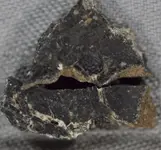I think you have a very vivid imagination. The meteorite you’re showing is NWA6687 and lifted from Randy Korotov’s website (in fact it’s his photograph). Given that he’s Professor of Earth, Environmental, and Planetary Sciences at Washington University in St Louis and a world-class authority on meteorites, it’s perhaps a little remiss of him not to have mentioned any fossils in the picture.
Geologically, NWA6687 is a mixture of lunar mare basalt and impact-melt breccia. Not exactly the kind of rocks in which fossil structures of any kind would be expected to be seen. As far as I know no-one has ever suggested the realistic possibility of fossil structures in a lunar meteorite (nor in lunar rocks brought back by missions to the Moon). Martian meteorites, yes, and notably ALH84001.
Although ALH84001 formed originally from basaltic magma (which couldn’t possibly contain any fossils) it does at least have additional carbonate and other deposits/alterations and is the only known Martian meteorite which can be dated to a time when Mars may have had liquid surface water. However, the organic molecules identified within it are now believed to be from abiotic processes (serpentinization and carbonation reactions that occurred during the aqueous alteration of the basaltic rock by hydrothermal fluids) plus probably some terrestrial contamination after it fell on Earth. Also the microscopic structures originally proposed to be fossil life forms have since been demonstrated to be recreatable in the lab without any biological input.
In short, there are no meteorites known to contain fossil structures and no known sedimentary meteorites, which would be most likely kind of geology to have preserved such fossils.




